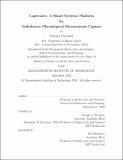Captivates : a smart eyewear platform for ambulatory physiological measurement capture
Author(s)
Chwalek, Patrick(Patrick C.)
Download1227785031-MIT.pdf (36.23Mb)
Alternative title
Smart eyewear platform for ambulatory physiological measurement capture
Other Contributors
Program in Media Arts and Sciences (Massachusetts Institute of Technology)
Advisor
Joseph A. Paradiso.
Terms of use
Metadata
Show full item recordAbstract
Smart environments amplify the lived experience within a space by learning and adapting to the preferences of the users within them. Unfortunately, these preferences are dependent on internal cognitive states of users, a characteristic that is not available to be sensed robustly across contexts. In addition, many sensing systems that are designed to sense users within specific contexts but often fail to adequately address privacy concerns. Captivates are a wearable eyeglass platform that attempts to fill this gap in sensing, allowing for the capture of physiological signals that have shown correlation to specific cognitive states. The system was designed with a few diverse sensing technologies that as a whole, can create a robust cognitive sensing architecture that won't impede a user's experience. Captivates are designed to be used across contexts and throughout the day, collecting samples of your physiological responses that can better inform individualized models of a user's internal states, leading to a more responsive environment that takes the human element into consideration. Captivates are able to continuously sample and stream data through a wireless network that is mesh-capable, allowing for applications that require scale with limited infrastructure. The sensing modalities include face temperature, blink rate, head pose, and 3D location but can be extended or reduced for other applications. The system was built using recommendations from eyeglass manufacturers on how to create a robust smart eyewear system that shares the aesthetic of more traditional eyeglasses. The system was initially designed to aid in data collection for cognitive modelling efforts but is also a platform for others to use for similar or orthogonal researcher efforts. Apart from the sensing channels, several touch points and LEDs exist on the device to allow for applications that require user input or actuation.
Description
Thesis: S.M., Massachusetts Institute of Technology, School of Architecture and Planning, Program in Media Arts and Sciences, September, 2020 Cataloged from student-submitted PDF version of thesis. Includes bibliographical references (pages 101-106).
Date issued
2020Department
Program in Media Arts and Sciences (Massachusetts Institute of Technology)Publisher
Massachusetts Institute of Technology
Keywords
Program in Media Arts and Sciences